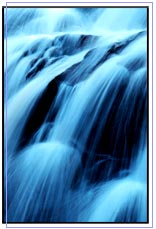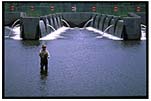Water Quality
 The
quality of the water in the Tennessee River system affects not only the
people who live in the Valley but also business and industry and the
plant
and animal life that are part of the river ecosystem. In managing the river system, TVA uses an integrated method
that balances water quality with the other demands on the system.
The
quality of the water in the Tennessee River system affects not only the
people who live in the Valley but also business and industry and the
plant
and animal life that are part of the river ecosystem. In managing the river system, TVA uses an integrated method
that balances water quality with the other demands on the system.
TVA does not have the authority to regulate water pollution. The Environmental Protection Agency and each of the Valley states that share the river, set their own pollution regulations and grant discharge permits. Those controls are mostly focused on business and industrial operations located along the river. However, it is your responsibility to keep trash and other pollutants from getting into the waterway by responsibly managing how you dispose of wastes.
Reservoir ratings
The first step in managing water quality is determining the actual health of the river. TVA rates the condition of each reservoir based on five ecological indicators. View those ratings here.
Fish populations
TVA and state agencies issue sport fishing ratings of the region’s reservoirs, indicating the availability of important sport species. TVA’s annual Spring Sportfish Survey monitors the size and health of bass populations in a number of reservoirs.
 Clean
water
Clean
water
TVA works with other agencies, communities, and industries to improve water quality. In 1992, it began the Clean Water Initiative, which helps ensure the benefits of clean water for communities and aquatic life.
Clean marinas and clean boating
Boating is one of the most popular recreational uses of TVA reservoirs. TVA’s Tennessee Valley Clean Marina Initiative certifies marinas that are in compliance with pollution-control standards. TVA is also an active participant in the national Clean Boating Campaign, helping educate boating enthusiasts and marina operators in practices that reduce pollution and erosion on the waterways.
Reservoir releases improvements

South Holston Labryinth Weir
Two conditions related to hydropower production can be harmful to fish and other forms of aquatic life: low concentrations of dissolved oxygen in the water released through the dam during generation, and dry riverbeds that result when hydro generation is shut off. Since the early 1990s, TVA has spent about $60 million to address these problems.
TVA has installed equipment and changed operations at many of its dams to add life-sustaining oxygen to the tailwater (the area below the dam) and to maintain a more constant wetted habitat. Studies show that these improvements have benefited aquatic life in more than 300 miles of river and resulted in a dramatic increase in tailwater fishing, which aids local economies. Learn more.
Stream discharges
Like all industries that operate on the Tennessee River, TVA must also obtain discharge permits under the National Pollution Discharge Elimination System. Most of what is discharged into the river by TVA is water that has been heated during the process of generating electricity at coal-fired and nuclear plants. However, storm water, sewage, and substances produced by activities like coal and ash handling and equipment cooling are also treated and released within the limits set by a permit.
All of TVA’s power generation facilities hold discharge permits, as do some of its maintenance and power service shops. Each permit is very specific, and discharge limits are set at levels that protect aquatic life and human health.